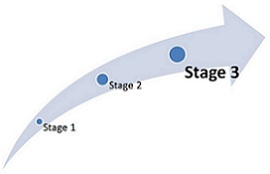More Stage 3 planning taking place on Patient Engagement
 On June 8th three Federal Advisory Committee workgroups hosted a hearing to explore how patient-generated health data (PGHD) could fit into meaningful use of EHRs in Stage 3. The three workgroups were:
On June 8th three Federal Advisory Committee workgroups hosted a hearing to explore how patient-generated health data (PGHD) could fit into meaningful use of EHRs in Stage 3. The three workgroups were:
- HIT Policy Meaningful Use Workgroup: The group makes recommendations to the HIT Policy Committee on how to define meaningful use in the short- and long-term; the ways in which electronic health records (EHRs) can support meaningful use; and how providers can demonstrate meaningful use.
- HIT Policy Quality Measures Workgroup: The group produces initial recommendations on quality measure prioritization and the quality measure convergence process pertaining to measure gaps and opportunities for Stage 2 Meaningful Use.
- HIT Standards Consumer/Patient Engagement Power Team: The group assesses Standards and Certification Criteria NPRM and provide recommendations for strengthening consumer/patient engagement components. The Power Team will prioritize recommendations to enable patients to participate as partners in their care.
The groups are now seeking additional comments like they did for stage 2, through their blog. According to the post, these are the areas they are seeking comment:
- How can we ensure that patients’ reports of symptoms and their knowledge of their own contraindications make their way into EHRs?
- Although there clearly is a need to have a structure for PGHD, does all PGHD for care management need to be in a structured form?
- In order to manage the legal, policy, and operational issues associated with provider collection of PGHD, what should individual providers do to ensure they have a plan for managing that data?
- Patients – particularly those living with chronic conditions – have an ongoing stream of information, for which clinical encounters with the delivery system are infrequent data points. What is the relationship between that data stream and the EHR?
- Although PGHD has some specific needs, identification and sourcing of all data sources are important; how can addressing PGHD management issues help clarify how data sources are tagged more generally in the EHR?
- For which health issues is it clear that patients and families are the authoritative source?
- How should we balance the need to build in the capability for providers to incorporate structured PGHD into the EHR without being overly prescriptive?
- Similarly, how should we balance the concern about being overly prescriptive with ensuring a certain degree of interoperability, usability and understandability of PGHD?
- What important implications does PGHD have for the robustness of clinical decision support, quality measurement, and care coordination?
- How can collection of PGHD address health disparities and what cautions exist to ensure that disparities are not widened?
Kaiser Permanente Medical Care Program has posted a comment this week. You can even be a part of the discussion by liking or disliking currently posted comments. Read the full post and comments already submitted.
